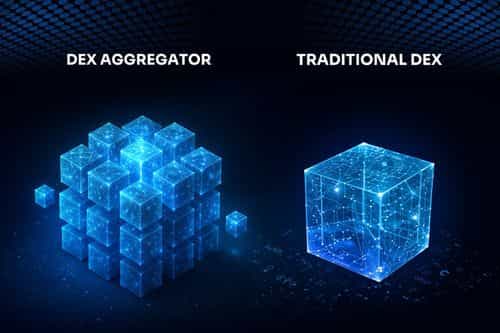How to Use Automated Market Makers for Crypto Investments


AMMs turn liquidity into code, and code into edge. This guide demystifies how pricing curves, from constant-product (x·y = k) to stableswap hybrids, shape execution quality, slippage, and fee capture; where concentrated liquidity converts tight ranges into superior capital efficiency; and why impermanent loss emerges as order flow continuously rebalances your inventory. You’ll learn to choose fee tiers by volatility, route across pools for best price, and size ranges with engineer-level precision, then monitor, rebalance, and harvest to turn volatility into durable yield. Now, go and read the article below.
1. Choose an AMM Platform
Pick the curve that matches your asset behavior and your ability to manage positions: constant-product (x·y = k) handles volatile pairs (token pairs whose price relative to each other can move fast and by large percentages) but introduces convex price impact (the bigger the trade, the more each extra unit moves the price, so slippage ramps up non-linearly); stableswap’s hybrid curve (a pricing formula that behaves almost like a flat line near 1:1 so small trades between near-pegged assets barely move the price) flattens around 1:1, minimizing slippage for correlated assets; weighted (e.g., 80/20) pools express directional bias and can lower divergence (the gap between the value of your LP position and just holding the tokens when prices move, often called impermanent loss) vs 50/50; and concentrated liquidity (v3-style) packs depth into price bands for higher capital efficiency when you can re-range. Price/fee architecture matters: tighter fee tiers (0.01%–0.05%) fit blue-chips and stables, mid/large tiers (0.3%–1%) compensate LPs on volatile pairs. Favor audited, high-liquidity deployments with robust routing across L1/L2s, and evaluate protocol governance (upgrade keys, oracle/MEV posture) as part of platform risk.
2. Set Up a Crypto Wallet
Use a non-custodial wallet on the target chain and pre-fund gas (e.g., ETH on Ethereum/L2s). Treat the seed as root authority: generate offline, shard/backup in separate locations, and avoid cloud storage. Prefer hardware wallets for treasury/LPs; keep a smaller hot wallet for execution. Lock down allowances (no unlimited approvals), verify chain IDs and RPC endpoints, and maintain an allowlist of official dApps. Multi-chain users should enable ENS and curated chain lists to avoid spoofed networks and failed routes; advanced users can consider smart accounts (session keys, spend limits) to make active LP management safer.
3. Connect Your Wallet to the AMM
Connect in read-only mode first, then grant minimal token approvals per dApp and per asset; ensure your wallet network matches the AMM’s (Ethereum vs specific L2 vs alt-L1). For best execution, compare native AMM routes with aggregator routes that stitch multiple pools and chains, this often reduces path-dependent slippage and MEV exposure. Keep a “gas tank” on destination chains for bridging/position edits, and verify the site’s domain/cert to avoid phishing.
4. Swap Cryptocurrencies Using an AMM
On constant-product pools, a trade moves reserves (x, y) along x·y = k; the instantaneous price is p = y/x, and slippage scales non-linearly with trade size vs. reserves. In v3-style AMMs, price traverses ticks (discrete price steps that define where liquidity is active) and effective depth depends on how much concentrated liquidity sits inside the active range. Execution quality = BaselinePrice − (Slippage + FeeCost + GasCost); for large orders, split sizes, route across pools, or schedule during lower gas to avoid adverse fills. Always set a slippage bound and preview outputs before confirming.
5. Provide Liquidity to Earn Passive Income
LPs earn fees pro rata but face impermanent loss because order flow keeps rebalancing your inventory away from HODL proportions; your realized PnL equals fee income minus IL (and gas). Stableswap reduces curvature near the peg, which lowers IL for small deviations, but it does not imply lower fees, fee levels depend on the specific pool’s parameters, not the curve model. Volatile pairs can pay more but swing harder; weighted pools tilt exposure (e.g., 80/20) to dampen divergence vs. a 50/50 pool.
6. Yield Farming for Extra Rewards
Incentive programs add token emissions to the fee APR, but the net APY must account for impermanent loss, reward token volatility, compounding cadence, and gas. Emissions decay, and high beta in the reward token can erase headline yields; treat farming as leveraged exposure unless you regularly convert rewards to your base asset or stables. Prefer audited, time-bounded programs with transparent schedules, and avoid locking LP tokens in opaque contracts that add smart-contract risk.
Note: “Fees” in the formula refer to compounding fee accrual, but they are represented linearly in the formula for simplicity!
7. Monitor and Manage Your Investments
Track fee APR, volume, realized slippage on entries/exits, and IL vs a HODL benchmark. For concentrated liquidity, watch tick utilization and liquidity clustering; when price exits your band, you become one-sided inventory and stop earning until you re-range. Use analytics to simulate fee/IL paths, and define playbooks for drift (widen bands for uptime, narrow when you can monitor). Incorporate protocol/governance risk (oracle changes, fee votes) into sizing and rebalancing frequency.
8. Withdraw Liquidity & Swap Rewards
Burn LP shares to withdraw; what you receive mirrors current pool composition (in v3, closing outside your range crystallizes skew, e.g., mostly one asset). Claim fees/incentives, then rebalance rewards into your target base or stables to lock PnL; plan around gas spikes and potential tax events. During stress or depeg, expect curvature/imbalance to amplify exit impact, simulate before confirming.
Final Tips
Diversify across curve types and time horizons; start with a smaller notional, measure fee density, then scale. Let thesis dictate structure (stableswap for cash-like yield, weighted for bias, concentrated liquidity for active makers). Use multi-route execution to compress slippage, keep allowances tight, and document a rebalance policy so decisions are rule-driven, not reactive.
Resources
Frequently asked questions
Check out most commonly asked questions, addressed based on community needs. Can't find what you are looking for?
Contact us, our friendly support helps!
Are AMMs safer than order books?
AMMs aren’t inherently “safer” than order books, they have different risk profiles. AMMs remove custody and centralized matching-engine risk, and their pricing is transparent, but they expose LPs to impermanent loss and traders to MEV and slippage. Order books offer tighter pricing in liquid markets but depend on centralized infrastructure, can suffer from latency games, and concentrate risk in a matching engine. Safety depends on the asset, liquidity, venue, and execution method rather than the model itself.
What is a session key, and how does it make DeFi and wallet usage safer?
A session key is a temporary, limited-permission key that lets a dApp or automation perform specific actions in your smart account without exposing your main private key. You choose what it can do, how much it can spend, and how long it stays valid. Because it operates with strict, predefined limits, even if a session key is compromised the impact is contained, and you can revoke it instantly, making DeFi activity and active LP management much safer.
What is MEV and how can I minimize its impact when swapping tokens?
MEV (Maximal Extractable Value) refers to value extracted by searchers, validators, or bots by reordering, inserting, or copying transactions around yours. This can cause sandwich attacks, front-running, or poor execution.
You can reduce MEV impact by:
These methods directly reduce your MEV exposure and generally lead to more consistent execution quality.




